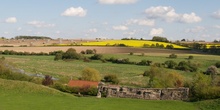Agriculture & Land Management
Our Work
Latest in Delivering Public Goods
-
The PEGASUS project publishes its first Newsletter
Welcome to the first newsletter of the PEGASUS project! It provides information on the project’s progress to date and details on the 34 case studies currently underway in 10 EU countries examining how to ensure the improved delivery of public goods and ecosystem services in different farming and forestry situations.
-
Improving environmental financing via result-based agri-environment measures
A new article by IEEP explores the use of result-based agri-environment measures in the region of Baden-Württemberg, Germany. The study shows that result-based schemes can increase the environmental effectiveness and conditionality of the EU Common Agricultural Policy.
-
CAP greening: what are its environmental prospects?
A significant injection of money was agreed for ‘green’ farming practices under the recent CAP reform. This report examines the environmental impact these measures are likely to have on the ground and concludes that Member States’ implementation choices appear to have much diminished the chances of the greening measures delivering significant additional environmental benefits.
-
New PEGASUS website
Project website for EU research project PEGASUS goes live!
-
Sustainable intensification of European agriculture
The concept of sustainable intensification has come into prominence in the context of global food security. This report defines what we mean by sustainable intensification, explains its global logic, discusses what it means for EU agriculture and exemplifies this in three case studies for soil performance, nutrient recycling and biodiversity.
-
High Nature Value farming throughout EU-27 and its financial support under the CAP
This study reviews Member States’ estimates of the extent of HNV farmland and use of RDP measures and the CMEF indicators, then identifies future priorities for CAP support for HNV farming and discusses the support opportunities under the reformed CAP. It offers detailed new evidence about the combined effect of Pillar 1 and Pillar 2 CAP payments on the economic and environmental viability of a typical HNV farming system in three Member States.
-
New report: High Nature Value Farming in the EU
Member States need to make the most of the opportunities under the new Common Agricultural Policy if the declines in HNV farming, critical for meeting our 2020 biodiversity targets, are to be halted.
-
Environment undermined in CAP deal
An attempt by the European Commission to place the environment more centrally within agricultural policy has been comprehensively watered down in the final agreement.
-
Land as an Environmental Resource
How can we meet the different and often conflicting demands we make on our limited supply of rural land in Europe? A more strategic approach to the way in which land is used is needed than has been the case in the past. This report for DG Environment looks at the data, the challenges and the policy options for Europe.
-
A greener CAP: still within reach?
The greening of the CAP hangs in the balance in the final negotiations; a synthesis of key issues and requirements.
-
Principles of Double Funding
This briefing explores the issue of double funding in relation to the CAP reform debate and considers the implications for delivering added value for the environment.
-
EP vote must not undermine a greener CAP
A decade’s progress in improving the Common Agricultural Policy’s environmental credentials risks being lost if the EP vote to water down the Commission’s ambitious proposals to green the CAP.
-
Land Stewardship in England post 2013: CAP greening and agri-environment
What will the introduction of environmental measures in Pillar 1 mean for agri-environment schemes in the future? A topic of much debate as part of the CAP reform negotiations, this new report explores the potential impacts of greening Pillar 1 on England’s entry-level agri-environment scheme and how a future scheme could be designed to deliver more for the environment and ensure the long term sustainability of farming.
-
Designing RDPs fit for the environment
Substantial changes to rural development regulation have been proposed which provide significant opportunities for Member States to deliver more for the environment. This report highlights some of these opportunities and sets out a series of principles and environmental priorities to help guide Member States in designing their future rural development programmes.
-
Systemic approach to adaptation to climate change and renewable energy harnessing (Biomass and Mini-hydro)
Biochar has the potential to both mitigate greenhouse gases, and to act as an adaptation measure in terms of responding to the impacts of climate change. Based on its compatibility with the appropriate soil properties, it could increase the resilience of soil to erosion.
-
Maximising environmental benefits through Ecological Focus Areas
Of the three measures proposed to 'green' Pillar 1 direct payments, Ecological Focus Areas have the greatest potential to address a range of environmental concerns. How much of this potential is realised depends on a number of key factors discussed in this new IEEP report prepared at the request of the Land Use Policy Group.
-
Addressing the EU’s biodiversity goals through the CAP
What is the relationship between the management of agricultural land and biodiversity? To what extent are the EU’s biodiversity goals addressed through the CAP?
-
Delivering environmental benefits through entry-level agri-environment schemes in the EU
A new study of the 2007-13 agri-environment schemes across the whole of EU-27 provides the first typology of ‘entry-level’ agri-environment management and environmental objectives, plus a detailed insight into the design of entry-level agri-environment schemes and calculation of payment rates in seven Member States.
-
Delivering Environmental Benefits through Ecological Focus Areas
IEEP workshop on 6 March brought together a range of stakeholders to discuss possible environmental benefits through Ecological Focus Areas.
-
Redesigning the CAP to deliver public goods
As a contribution to the CAP reform debate, this report considers options for redesigning the Common Agricultural Policy (CAP) to maximise the delivery of public goods, particularly in relation to the environment and rural vitality.
Highlights
-

CAP greening: what are its environmental prospects?
A significant injection of money was agreed for ‘green’ farming practices under the recent CAP reform. This report examines the environmental impact these measures are likely to have on the ground and concludes that Member States’ implementation choices appear to have much diminished the chances of the greening measures delivering significant additional environmental benefits.
-

Land as an Environmental Resource
How can we meet the different and often conflicting demands we make on our limited supply of rural land in Europe? A more strategic approach to the way in which land is used is needed than has been the case in the past. This report for DG Environment looks at the data, the challenges and the policy options for Europe.
-

Redesigning the CAP to deliver public goods
